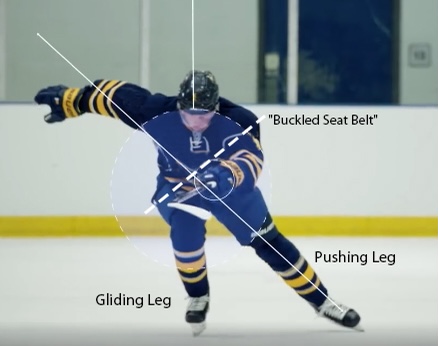
Three Simple Exercises for Hockey Players and Speedskaters to Build a Powerful, Efficient Stride
A skater will briefly use short choppy strides when changing direction from backwards to forwards (hockey), or when starting a race (speedskating). However, in terms of building and maintaining maximum speed, both athletes need to develop a long stride. In simple terms, a long stride is one where the pushing leg reaches full extension, and the athlete is able to balance on the gliding leg long enough to begin loading that leg for the next push. The following activities require minimal equipment and will pay big dividends.
- Hard Roll
Skating power starts in your core, not your legs. The Hard Roll is a great way to work on mid-section strength and control while moving, which is the foundation for a powerful and efficient skating stride.
Skaters need to counter-balance leg drive by “buckling the seat belt” from the shoulder to the opposite knee. If the upper body rotates away from the extending leg or bobs up from the ice, energy is wasted because the athlete is not putting maximum pressure into the ice with each push.
Start with six reps on each side, and progress to ten. If you cannot keep your elbow pressed to your knee throughout the slow roll down to the floor and back, use a prop such as a soccer ball.
- Foot-Elevated Hip Extension
This exercise can be done with heel on a four- to six-inch block/step, a foam roller, or medicine ball. A medicine ball is the most difficult option, but provides the most benefit to skaters in that the instability in all directions requires more work from the hip stabilizers. Weak hip stabilizers allow the knee to cave in towards the center of the body, and the skater is then unable to balance on one leg long enough to bring the recovery leg around load up for a powerful push.
Start with eight reps each leg and progress to 12. Think about driving your heel into the block or ball and keeping your navel sucked in towards your spine during each rep.
- Slideboard Load and Push
While many people tout the slideboard as a conditioning tool, I prefer to see skaters use it as a way to build sound technical patterns. Sometimes you have to slow a movement down and develop a visceral feel for small adjustments to technique in order to go faster down the line.
In this video, I am thinking about keeping a “pocket” at my hip bone, and squeezing those core muscles as I load my gliding leg. I force myself to work on balancing on that leg as I circle my recovery leg around after each push. In addition, I am thinking about keeping my opposing shoulder buckled down as I transition from one push to the next. Obviously I am in a low, speedskating position, and a hockey player would keep their chest up higher in order to see the entire ice surface. Nonetheless, the principles of force development and body control apply to both disciplines, and to cross-overs as well as straight-away strides.
For more information:
Boyle, Michael. Functional Training for Sports. Champaign, IL: Human Kinetics, 2004.
Stamm, Laura. Power Skating. Champaign, IL: Human Kinetics, 2010.
Maura J. Zimmer, NSCA-CPT, CSCS is a strength and conditioning coach at Olympia Fitness + Performance in Cranston, RI, and a three-time national champion in masters short-track speedskating. She specializes in helping people progress from physical therapy back to fully enjoying the activities they love.

